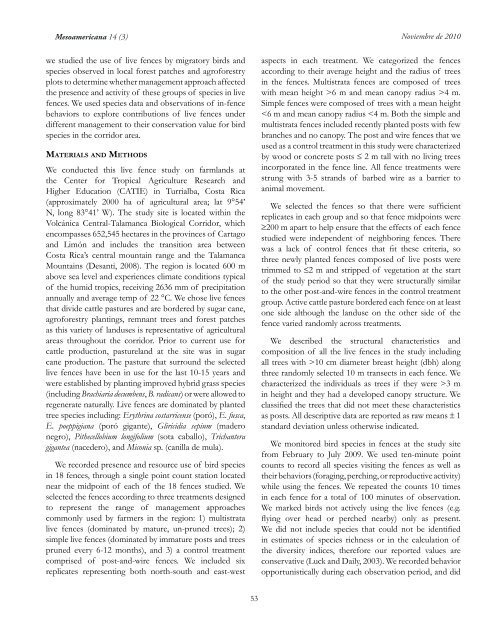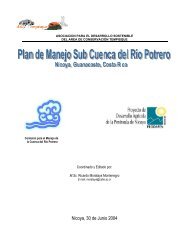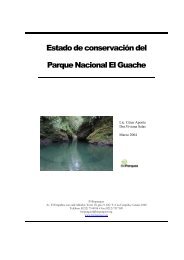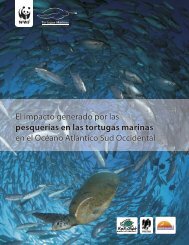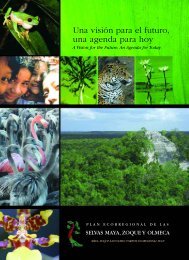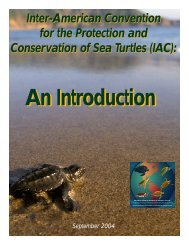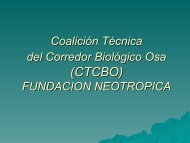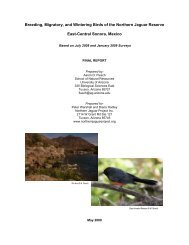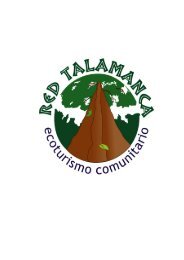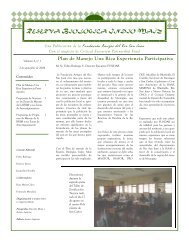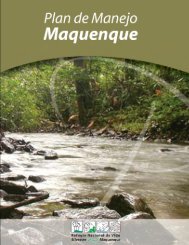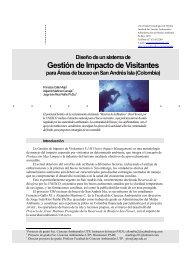Mesoamericana <strong>14</strong> (3) <strong>Noviembre</strong> <strong>de</strong> <strong>2010</strong>In t r o d u c t i o nThere is growing recognition of the need to evaluate thecapacity of agricultural systems to support biodiversityconservation. This challenge is especially pressing inMesoamerica, a biodiversity hotspot where approximately80% of the region’s vegetation has been converted toagriculture (Harvey et al., 2008), and where the landscapehas become increasingly fragmented (Laurance andBierregaard, 1997; Harvey et al., 2006). The survival ofwildlife in agricultural areas and other fragmented habitatsmay ultimately <strong>de</strong>pend on their ability to move throughthe landscape in or<strong>de</strong>r to access resources, maintaingenetic diversity and ensure the reproductive capacityof populations (Petit et al., 1995; Wiens, 1996; Lauranceand Bierregaard, 1997; Buza and Thrall, 2000). Lack ofmovement between forest fragments for individuals ofsmall populations may lead to local extinction (Andrén,2004).Establishing biological corridors has been proposedas a means to maintaining connectivity of habitat an<strong>de</strong>nsuring the survival of animal populations (Bennett,1999; Perlault and Lomolino, 2000). In addition, corridorscan mitigate the negative effects of human impacts andfragmentation by connecting areas of otherwise isolatedhabitat (Soulé, 1991). However, the conservation valueof corridors has been <strong>de</strong>bated, largely due to lack ofempirical data <strong>de</strong>monstrating their use by populationsthreatened by fragmentation (Hilty and Merenlen<strong>de</strong>r,2004). In large corridors that encompass agricultural areasand various landuses, data on how the management ofdifferent elements within <strong>de</strong>signated corridors influencesresource use and movement among wildlife speciesis lacking. Management that <strong>de</strong>termines compositionand complexity of corridor elements is expected to beparticularly influential given that some species may usevegetation strips and patches selectively, making useonly of areas that are floristically diverse or of certaindimensions (Laurance and Laurance, 1999). Determiningthe influence of different management strategies uponcorridor elements and corresponding resource use amonglocal wildlife populations should be <strong>de</strong>termined in or<strong>de</strong>r tocorrectly assess their contributions to conservation goalsand to best advice land managers and planners.Live fences are common elements in agricultural landsthroughout Mesoamerica. They form linear networks oftrees bor<strong>de</strong>ring cattle pastures and are dispersed throughoutcroplands and agroforestry systems (Harvey et al., 2005).Live fences provi<strong>de</strong> vertical complexity and tree cover inotherwise structurally simple pasture environments, whichis an important landscape characteristic (Wiens, 1996). Theymay also provi<strong>de</strong> resources for wildlife and connectivityamong patches of remnant forest and agroforestry plantings(Estrada et al., 2000; León and Harvey, 2006). Live fencesare most commonly incorporated as productive featuresof farmlands, providing barriers to livestock movement,posts for new fences, fod<strong>de</strong>r for livestock, timber an<strong>de</strong>dible fruit (Sauer, 1979; Beer, 1987; Somarriba, 1995;Harvey et al., 2005). However, the management variesaccording goals and objectives of individual land managersranging from very simple, single species live fences thatare regularly pruned, to highly complex, species rich livefences that are never pruned. These differences can haveimportant influences on the contributions of live fencesmake to both the conservation value and productivity offarmlands.Due to their potential productive and conservation roles,live fences have been wi<strong>de</strong>ly promoted by conservationprograms including the World Bank’s Payment for<strong>Eco</strong>system Services initiative in Colombia, Nicaragua,and Costa Rica. Reviews of experiences with Payment for<strong>Eco</strong>system Services indicated high adoption rates of livefences and other elements used to promote conservationin agricultural landscapes (Pagiola et al., 2005). However,existing studies emphasize adoption rates and other processvariables while much work is still nee<strong>de</strong>d to un<strong>de</strong>rstan<strong>de</strong>cological outcomes of live fence use and management.Currently, resource and land management agencies,environmental organizations, and government associationsare <strong>de</strong>bating how to boost biodiversity conservation infarmlands and cattle ranches by increasing the use of livefences and other farm features that are expected to havehigh conservation value. Field data is nee<strong>de</strong>d to <strong>de</strong>terminewhether these conservation interventions are having the<strong>de</strong>sired ecological effects and to <strong>de</strong>termine how theirmanagement can be improved to increase their usefulnessto a diverse range of species.We documented bird species in live fences, and theirpatterns of resource use, in the context of a landscapedominated by agriculture in Costa Rica’s Volcánica Central-Talamanca Biological Corridor. Our first goal was to assessthe effect of live fence management and structure on birddiversity because these characteristics are often tailored forproductive aims. Distinct management approaches suchas species selection and pruning intensity/frequency maynot provi<strong>de</strong> the same conservation benefits. Additionally,52
Mesoamericana <strong>14</strong> (3) <strong>Noviembre</strong> <strong>de</strong> <strong>2010</strong>we studied the use of live fences by migratory birds andspecies observed in local forest patches and agroforestryplots to <strong>de</strong>termine whether management approach affectedthe presence and activity of these groups of species in livefences. We used species data and observations of in-fencebehaviors to explore contributions of live fences un<strong>de</strong>rdifferent management to their conservation value for birdspecies in the corridor area.Ma t e r i a l s a n d Me t h o d sWe conducted this live fence study on farmlands atthe Center for Tropical Agriculture Research andHigher Education (CATIE) in Turrialba, Costa Rica(approximately 2000 ha of agricultural area; lat 9°54’N, long 83°41’ W). The study site is located within theVolcánica Central-Talamanca Biological Corridor, whichencompasses 652,545 hectares in the provinces of Cartagoand Limón and inclu<strong>de</strong>s the transition area betweenCosta Rica’s central mountain range and the TalamancaMountains (Desanti, 2008). The region is located 600 mabove sea level and experiences climate conditions typicalof the humid tropics, receiving 2636 mm of precipitationannually and average temp of 22 °C. We chose live fencesthat divi<strong>de</strong> cattle pastures and are bor<strong>de</strong>red by sugar cane,agroforestry plantings, remnant trees and forest patchesas this variety of landuses is representative of agriculturalareas throughout the corridor. Prior to current use forcattle production, pastureland at the site was in sugarcane production. The pasture that surround the selectedlive fences have been in use for the last 10-15 years andwere established by planting improved hybrid grass species(including Brachiaria <strong>de</strong>cumbens, B. radicans) or were allowed toregenerate naturally. Live fences are dominated by plantedtree species including: Erythrina costarricense (poró), E. fusca,E. poeppigiana (poró gigante), Gliricidia sepium (ma<strong>de</strong>ronegro), Pithecellobium longifolium (sota caballo), Trichanteragigantea (nace<strong>de</strong>ro), and Miconia sp. (canilla <strong>de</strong> mula).We recor<strong>de</strong>d presence and resource use of bird speciesin 18 fences, through a single point count station locatednear the midpoint of each of the 18 fences studied. Weselected the fences according to three treatments <strong>de</strong>signedto represent the range of management approachescommonly used by farmers in the region: 1) multistratalive fences (dominated by mature, un-pruned trees); 2)simple live fences (dominated by immature posts and treespruned every 6-12 months), and 3) a control treatmentcomprised of post-and-wire fences. We inclu<strong>de</strong>d sixreplicates representing both north-south and east-westaspects in each treatment. We categorized the fencesaccording to their average height and the radius of treesin the fences. Multistrata fences are composed of treeswith mean height >6 m and mean canopy radius >4 m.Simple fences were composed of trees with a mean height3 min height and they had a <strong>de</strong>veloped canopy structure. Weclassified the trees that did not meet these characteristicsas posts. All <strong>de</strong>scriptive data are reported as raw means ± 1standard <strong>de</strong>viation unless otherwise indicated.We monitored bird species in fences at the study sitefrom February to July 2009. We used ten-minute pointcounts to record all species visiting the fences as well astheir behaviors (foraging, perching, or reproductive activity)while using the fences. We repeated the counts 10 timesin each fence for a total of 100 minutes of observation.We marked birds not actively using the live fences (e.g.flying over head or perched nearby) only as present.We did not inclu<strong>de</strong> species that could not be i<strong>de</strong>ntifiedin estimates of species richness or in the calculation ofthe diversity indices, therefore our reported values areconservative (Luck and Daily, 2003). We recor<strong>de</strong>d behavioropportunistically during each observation period, and did53


